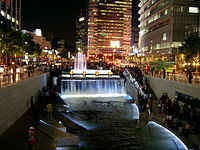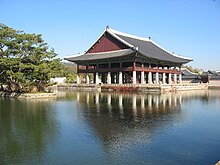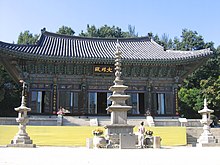Seul: Versiyalar orasidagi farq
Darkicebot (munozara | hissa) k Bot Qoʻshdi: roa-rup:Seoul |
k Bot Qoʻshdi: yo:Seoul |
||
| Qator 400: | Qator 400: | ||
[[war:Seoul]] |
[[war:Seoul]] |
||
[[wuu:首尔]] |
[[wuu:首尔]] |
||
[[yo:Seoul]] |
|||
[[zh:首爾]] |
[[zh:首爾]] |
||
[[zh-classical:首爾]] |
[[zh-classical:首爾]] |
||
28-Noyabr 2009, 20:14 dagi koʻrinishi
| 서울 Seul | ||||||||||||
|---|---|---|---|---|---|---|---|---|---|---|---|---|
| Gangnam1.jpg Seuldagi tong otish | ||||||||||||
| Koreyscha Nomi | ||||||||||||
| Andoza:Koyreyscha nom ma'lumot qutisi/NomQuti | ||||||||||||
| Qisqa Nomi | ||||||||||||
| Andoza:WikifyQalin matn | ||||||||||||
| Statistika | ||||||||||||
| ||||||||||||
| Joylashuv Haritasi | ||||||||||||
 Seulning joylashuv haritasi. |
|
Bu maqola inglizcha yozilgan. | |
|
Iltimos, maqolani oʻzbek tilga tarjima qiling. | |
Seul (ⓘ) Janubiy Koreyaning poytaxti. 10 milliondan ko'p axoliga ega Seul dunyoning yirik shaharlaridan biriga kiradi. Shuningdek Seul dunyodagi eng katta ikkinchi metropoliten shahar, Seul Milly Poytax Maydoni — Inchon shahri va Gyeonggi-doning bir necha shaharlarini o'zi ichiga olganda axolisi 23 milliondan oshadi. [2] Janubi Koreya axolisining deyarli yarmi Seul Milliy Poytaxti Maydonida yashaydi, chorak qismi esa Seulda. Shu sababdan Seul maxsus shahri deb ataladi va milliy hukumat tomonidan tog'ridan-tog'ri boshqariladi.
Shahar mamlakatning shimoliy-g'arbiy qismida Han Daryosi havzasida joylashgan. Seuldan 50 km shimolda esa Shimoliy Koreya joylashgan.
Seul birinchi bor tarixda 18 EA Pekche qirolligi o'z poytaxti Viryesonni hozirgi Seulning janubiy-sharqiy qismidagi Songpa-guda o'rnatgan paydo bo'ladi. Zamonaviy Seul Ko'ryo erasidagi Namgyon shahridan kelib chqib, Cho'son qirolligi davrida Koreyaning poytaxti bo'lgan.
Yirik moliyavi va madaniy markaz sifatida Seul [[global shahar] xisoblanadi. Seul 1988 Yozgi Olimpiada va 2002 FIFA Jahon Chempionatining mezboni bo'lgan. 2007 Dunyodagi eng yashash qimmat shaharlarning uchunchisi va Osiyodagi birinchi eng qimmat shahar sifatida topildi.[3]
So'nggi yillarda, Seoul Metropoliten Hukumati atrof muxitga oid yirik proyektlarni amalga oshirishni boshladi, jumladan Chxongyechxon ni tiklash uchun yaqin 1 milliard AQSh dollari sarfladi. Ayni vaqtda, the city has promoted the Seoul Digital Media City, the world's first complex for high-tech digital technologies in multi-media, IT, and entertainment, and the proposed future site of the world's second tallest building.[4][5]
Nomlari
The city has been known in the past by the successive names Wirye-seong (위례성; 慰禮城, Baekje era), Namgyeong (남경; 南京, Goryeo era), Hanseong (한성; 漢城, Joseon era), and Hanyang (한양; 漢陽). Its current name originated from the Korean word meaning "capital city," which is believed to be derived Seorabeol (서라벌; 徐羅伐), which originally referred to Gyeongju, the capital of Silla.[6]
Unlike most place names in Korea, "Seoul" has no corresponding hanja (Chinese characters used in the Korean language). The recently-chosen Chinese name for Seoul is 首爾 (Shǒuěr), which sounds somewhat similar to "Seoul" when pronounced in Mandarin Chinese.[7]
Tarixi


The history of Seoul can be traced back as far as 18 BC, when it was established as a settlement in Baekje. It's believed that the Wiryeseong site is in the boundaries of modern day Seoul. It has thereafter been the capital of the Joseon Dynasty. In the Japanese colonization period in the early 20th century, many historical and traditional parts of Seoul were changed. The city was almost entirely destroyed in the Korean War, but an aggressive economic policy in the 1960s and 1970s helped to rebuild the city very rapidly. In the 1990s, some important historical buildings were restored, including Gyeongbokgung, one of the royal palaces of the Joseon dynasty.
Jug'rofiyasi
Seoul is in northwest South Korea. Seoul proper comprises 605.39 km² of area, roughly bisected into northern and southern halves by the Han River. The Han River and its surrounding area played an important role in Korean history. The Three Kingdoms of Korea strove to take control of this land, where the river was used as a trade route to China (via the Yellow Sea). However, the river is no longer actively used for navigation, because its estuary is located at the borders of the two Koreas, barred for entrance by any civilian. The city is bordered by eight mountains, as well as the more level lands of the Han River plain and western areas.
Iqlimi
| Seoul | ||||||||||||||||||||||||||||||||||||||||||||||||||||||||||||
|---|---|---|---|---|---|---|---|---|---|---|---|---|---|---|---|---|---|---|---|---|---|---|---|---|---|---|---|---|---|---|---|---|---|---|---|---|---|---|---|---|---|---|---|---|---|---|---|---|---|---|---|---|---|---|---|---|---|---|---|---|
| Klimatogramma | ||||||||||||||||||||||||||||||||||||||||||||||||||||||||||||
| ||||||||||||||||||||||||||||||||||||||||||||||||||||||||||||
| ||||||||||||||||||||||||||||||||||||||||||||||||||||||||||||
In common with the rest of South Korea, Seoul has a generally humid continental climate, despite the fact that the country is surrounded on three sides by water.[8] Summers are generally hot and humid, with monsoons taking place from June until July. August, the hottest month, has an average temperature of 72 °F to 86 °F (22°C to 30°C) with higher temperatures possible. Winters are often very cold with an average January temperature of 19 °F to 33 °F (-7°C to 1°C) and are generally much drier than summers, although there are 28 days of snow in Seoul in each year on average.
Shahar ko'rinishi
The traditional heart of Seoul is the old Joseon Dynasty city, which is now the downtown area, where most palaces, government offices, corporate headquarters, hotels, and traditional markets are located. This area occupies the valley of Cheonggyecheon, a stream that runs from west to east through the valley before emptying into the Han River. For many years, the stream had been covered by concrete, but was recently restored through an urban revival project. To the north of downtown is Bukhan Mountain, and to the south is the smaller Namsan. Further south are the old suburbs of Yongsan-gu and Mapo-gu, and the Han River. Across the Han River are the newer and wealthier areas of Gangnam-gu,Seocho-gu and surrounding neighborhoods. The World Trade Center of Korea is located in Gangnam-gu and this is where many expositions and conferences are held. Also in Gangnam-gu is the COEX Mall, a large indoor shopping and entertainment complex. Bamseom is an island in the middle of the Han River near Yeouido, downstream from Gangnam-gu, and is home to the National Assembly, major broadcasting studios, and a number of large office buildings, as well as the Korea Finance Building and the world's largest Pentecostal church. The Olympic Stadium, Olympic Park, and Lotte World are located in Songpa-gu, on the south side of the Han River, upstream from Gangnam-gu. South of the sprawling Gangnam area are Namhan Mountain,Cheonggye Mountain and Gwanak Mountain.

Major modern landmarks include the Korea Finance Building, N Seoul Tower, the World Trade Center, the 63 Building and the six-skyscraper residence Tower Palace. These and various high-rise office buildings, like the Seoul Star Tower and Jongno Tower, dominate the city's skyline. Due to its high density, Seoul has been equipped with a grand appearance of skyscrapers and the city council is now planning on building a series of high-rises, including 580-metre business center in Sangam Digital Media City district and an 800-metre Lotte World 2 Tower in the Jamsil (pronounced "Jam-shil") district of Songpa-gu and Gangdong-gu.
Urban and civil planning was a key concept when Seoul was first designed to serve as a capital in the late 14th century. The Royal Palaces of the Joseon Dynasty still remain in Seoul, with the main palace, Gyeongbokgung currently being restored to its original form. Today, there are eight major subway lines stretching for more than 250 kilometers, with a ninth and tenth line being planned, and also some other miscellaneous lines.
The most historically significant street in Seoul is Jongro, meaning "Bell Street," on which one can find Bosingak, a pavilion containing a large bell. The bell signaled the different times of the day and therefore controlled the four major gates to the city. The only time it is normally rung nowadays is at midnight on New Year's Eve, when it is rung thirty-three times. It was, however, rung on the day that President Kim Dae-jung took office.
Seoul's most important streetcar line ran along Jongno until it was replaced by Line 1 of the subway system in the early 1970s. Other notable streets in downtown Seoul include Euljiro (을지로; 乙支路), Teheranno (테헤란路, Tehran Street), Sejongno (세종로; 世宗路), Chungmuro (충무로; 忠武路), Yulgongno (율곡로; 栗谷路), and Toegyero (퇴계로; 退溪路).
Maʼmuriy boʻlinishi

Seoul is divided into 25 gu (구; 區) (district)[9]. The gu vary greatly in area (from 10 to 47 km²) and population (from less than 140,000 to 630,000). Songpa has the most people, while Seocho, the largest area. The government of each gu handles many of the functions that are handled by city governments in other jurisdictions. Each gu is divided into "dong" (동; 洞) or neighbourhoods. Some gu have only a few dong while others like Jongno-gu have a very large number of distinct neighborhoods. Gu of Seoul consist of 522 administrative dongs (행정동) in total.[9] Dong are also sub-divided into 13,787 tong (통; 統), which are further divided into 102,796 ban in total.
|
|
Demografiyasi
Nearly all of Seoul's residents are Korean, with some small Chinese and Japanese minorities. A rapidly growing population of international residents now represent about 2% of the total population.[10] The city’s population surpassed 10,421,000 as of the end of 2007 and the number of foreigners was 229,000, constituting 2.2 percent of the population.[11]
The crime rate in Seoul is very low and it is considered one of the safest major cities in Asia. The two major religions in Seoul are Buddhism and Christianity. Other religions include Shamanism and Confucianism, the latter seen more as a pervasive social philosophy rather than a religion.
Iqtisodi
As the headquarters for some of the world’s largest corporations, such as Samsung, LG and Hyundai, Seoul has become a major business hub in Asia. Although Seoul accounts for only 0.6 percent of South Korea's land area, it generates 21 percent of the country's entire GDP.[12] Its per capita GDP ranks among the highest among large cities in the region.
Moliyaviy Yo'l
As a major business and financial center, Seoul ranks fifth in the world in terms of the number of Fortune 500 transnational companies headquartered there.[13] Many international banks have branches in Seoul, including Citigroup, HSBC and Mizuho Financial Group. One of the largest exchange banks, the Korea Exchange Bank, is also headquarted in Seoul.
Savdo

The largest market in South Korea, the Dongdaemun Market, is located in Seoul. Myeongdong is a shopping and entertainment area in downtown Seoul which contains some of the city's top stores and fashion boutiques. Nearby is the Namdaemun Market named after the Namdaemun Gate. Insadong is the cultural art market of Seoul, where traditional and modern Korean artworks, such as paintings, sculptures and calligraphy are sold. Itaewon is another notable shopping district in the city lined with boutiques and stores, mainly catering to foreign tourists and American soldiers based in the city. Shinchon is particularly popular with young people perhaps due to its proximity to some of Seoul's universities. The Gangnam district is one of the most affluent areas in Seoul and has popular modern shopping spots such as the fashionable and upscale Apgujeong-dong area and the COEX Mall.
Taʼlim
- Sh. qarang: Education in South Korea, List of universities in Seoul
There are a large number of universities in Seoul. Most of the country's most prestigious universities are located in Seoul.
Madaniyati





Tarixiy Binolar va Muzeylar
Cho'son Vassaligi "Besh Buyuk Qarorgoh" qurilgan:
- Chxandokkun (창덕궁; 昌德宮)
- Chxanggyongun (창경궁; (昌慶宮)
- Toksugun (덕수궁; 德壽宮)
- Kyonbokkung (경복궁; 景福宮)
- Kyonxigun (경희궁; 慶熙宮)
Muzeylar
- Koreya davlat muzeyi(국립중앙박물관; 國立中央博物館)
- National Folk Museum(국립민속박물관; 國立民俗博物館)
- War Memorial(전쟁기념관; 戰爭紀念館)
Metropoliten maydon tashqarisi:
- Namxansanson(남한산성; 南漢山城)
- Pukkansanson(북한산성; 北漢山城)
- Namsan Park(남산공원; 南山公園)
Ibodatxona va Ziyoratxonalar
- Chonmyo(종묘; 宗廟)
- Tonmyo(동묘; 東廟)
- Munmyo(문묘; 文廟)
- Chogyesa(조계사; 曹溪寺)
- Xvagyesa(화계사; 華溪寺)
- Ponynsa (봉은사; 奉恩寺)
Park va Attraksionlar
Andoza:Seealso Seoul's metropolitan area accommodates six major parks, including Seoul Forest, which opened in mid-2005. The Seoul National Capital Area also contains a green belt aimed to prevent the city from sprawling out over the neighboring Gyeonggi Province. These areas are frequently sought after by people resting on the weekend and during vacations.
In addition, Seoul is also home to the world's largest indoor amusement park, Lotte World. Other recreation centres include the former Olympic and World Cup stadiums and the City Hall's public lawn.
Sport
Seoul hosted the 1986 Asian Games, 1988 Olympic Games and Paralympic Games. It also served as one of the host cities of the 2002 FIFA World Cup. Seoul World Cup Stadium hosted the opening ceremony and first game of the tournament.
Taekwondo is Korea's national sport and Seoul is the location of the Kukkiwon, also known as the World Taekwondo Federation (WTF), the world headquarters of taekwondo.
The city is home to three baseball teams in the KBO: the Doosan Bears, the LG Twins, and Woori Heroes & two basketball teams in the KBL: the Seoul Samsung Thunders and Seoul SK Knights.
There is one professional football club in Seoul, FC Seoul, which plays in the K-League. Two K3 League teams are based in the capital, Seoul United and Eungpyeong Chung-goo FC.
Transportation
Seoul's transportation boom dates back to the era of the Korean Empire, when the first streetcar lines were laid and a railroad linking Seoul and Incheon was completed. Seoul was the first city in East Asia to have electricity, trolley cars, water, telephone, and telegraph systems all at the same time. Today, as a result of the diversification of the city's transportation network, it has become a great transportation hub for Asia.
Seoul hosts more than three million registered vehicles and widespread traffic congestion is common.
Airports
There are two international airports that serve Seoul. Gimpo International Airport, formerly in Gimpo but annexed to Seoul in 1963, was the only international airport for Seoul since its original construction during the Korean War. Other domestic airports were built around the time of the war, including at Yeouido.
Upon opening in March 2001, Incheon International Airport on Yeongjong island in Incheon changed the role of Gimpo Airport significantly. Incheon is now responsible for almost all international flights and some domestic flights, while Gimpo serves only domestic flights with the exception of flights to Haneda Airport in Tokyo and Hongqiao Airport in Shanghai. This has led to a significant drop in flights from Gimpo Airport.
Meanwhile, Incheon International Airport has become, along with Hong Kong and Singapore, a major transportation centre for East Asia. The 2005 AETRA passenger survey, jointly administered by the IATA and Airports Council International, voted it the best airport in the world.[14] It was named by Skytrax as the world's 5th best airport for 2006.[15]
Incheon and Gimpo are linked to Seoul by highways, and Gimpo is also linked by subway (line #5). The Incheon International Airport Railroad, a rail line connecting Incheon Airport to Gimpo Airport opened in March 2007, but the line to Seoul Station in central Seoul will take at least a year more to open. Shuttle buses transfer passengers between Incheon and Gimpo airports.

Bus
Seoul's bus system is operated by the Seoul Metropolitan Government, with four primary bus configurations available servicing most of the city.

Seoul has many big intercity/express bus terminals. These buses are connecting Seoul and cities all around Korea. Major bus terminals are
- Seoul Express Bus Terminal in Seocho-gu
- Central City in Seocho-gu
- Seoul Nambu Terminal, also in Seocho-gu
- Dongseoul Bus Terminal in Gwangjin-gu
- Sangbong Terminal in Jungnang-gu
Subway
Seoul has eight subway lines that interlink every district of the city with one another and with the surrounding area. The majority of the population now uses the public transportation system due to its convenience and low cost. With more than 8 million passengers a day, Seoul has one of the busiest subway systems in the world. In addition, in order to cope with all of these transportation modes, Seoul's metropolitan government employs several mathematicians to coordinate the subway, bus, and traffic schedules into one timetable. The 10 lines are run by Korail, Seoul Metro and SMRT.
Train

Seoul is connected to every major city in Korea by railroad. Seoul is also linked to most major Korean cities by the KTX bullet train which features a normal operation speed of more than 300 km/h, making commuting between cities extremely convenient for commuters and tourists. Major railroad stations include:
- Seoul Station, Jung-gu - Gyeongbu line (KTX/Saemaul/Mugunghwa-ho), Gyeongui line (Saemaul/Commuter)
- Yongsan Station, Yongsan-gu - Honam line (KTX/Saemaul/Mugunghwa), Jeolla/Janghang lines (Saemaul/Mugunghwa)
- Yeongdeungpo Station, Yeongdeungpo-gu - Gyeongbu/Honam/Janghang lines (Saemaul/Mugunghwa)
- Cheongnyangni Station, Dongdaemun-gu - Gyeongchun/Jungang/Yeongdong/Taebaek lines (Mugunghwa)
Sister cities
Seoul has many sister cities. The year each relationship was formed is shown in parentheses below.[16]
|
|
Havolalar
- ↑ http://english.seoul.go.kr/today/about/about_12stat.htm
- ↑ R.L. Forstall, R.P. Greene, and J.B. Pick, "Which are the largest? Why published populations for major world urban areas vary so greatly", City Futures Conference, (University of Illinois at Chicago, July 2004)– Table 5 (p.34)
- ↑ „Cost of living - The world's most expensive cities“. City Mayors.
- ↑ MIT CRE : Case Studies - Seoul Digital Media City
- ↑ Korea to build world's second-tallest building in Seoul's Yongsan area | Korea.net News
- ↑ yahoo
- ↑ goodcharacters.com
- ↑ BBC Weather - Country Guide
- ↑ 9,0 9,1 „Administrative Districts“ (English). Seoul Metropolitan Government. Qaraldi: 2008-yil 2-may.
- ↑ Park, Chung-a. „Foreign Population in Seoul Stands at 175,000“ (English). Korea Times (2007-yil 24-iyul). Qaraldi: 2008-yil 6-yanvar.
- ↑ [1][sayt ishlamaydi]
- ↑ Welcome to KTC
- ↑ Richard Child Hill and June Woo Kim. GLOBAL CITIES & DEVELOPMENTAL STATES. Retrieved 27 June 2006.
- ↑ „Airport Service Excellence Awards for 2005“. ACI (2006-yil 7-mart). Qaraldi: 2006-yil 25-avgust.
- ↑ „Airport of the Year 2006“. World Airport Awards. Skytrax. Qaraldi: 2007-yil 25-fevral.
- ↑ Seul Metropolitan Government. „International Cooperation: Sister Cities“.
